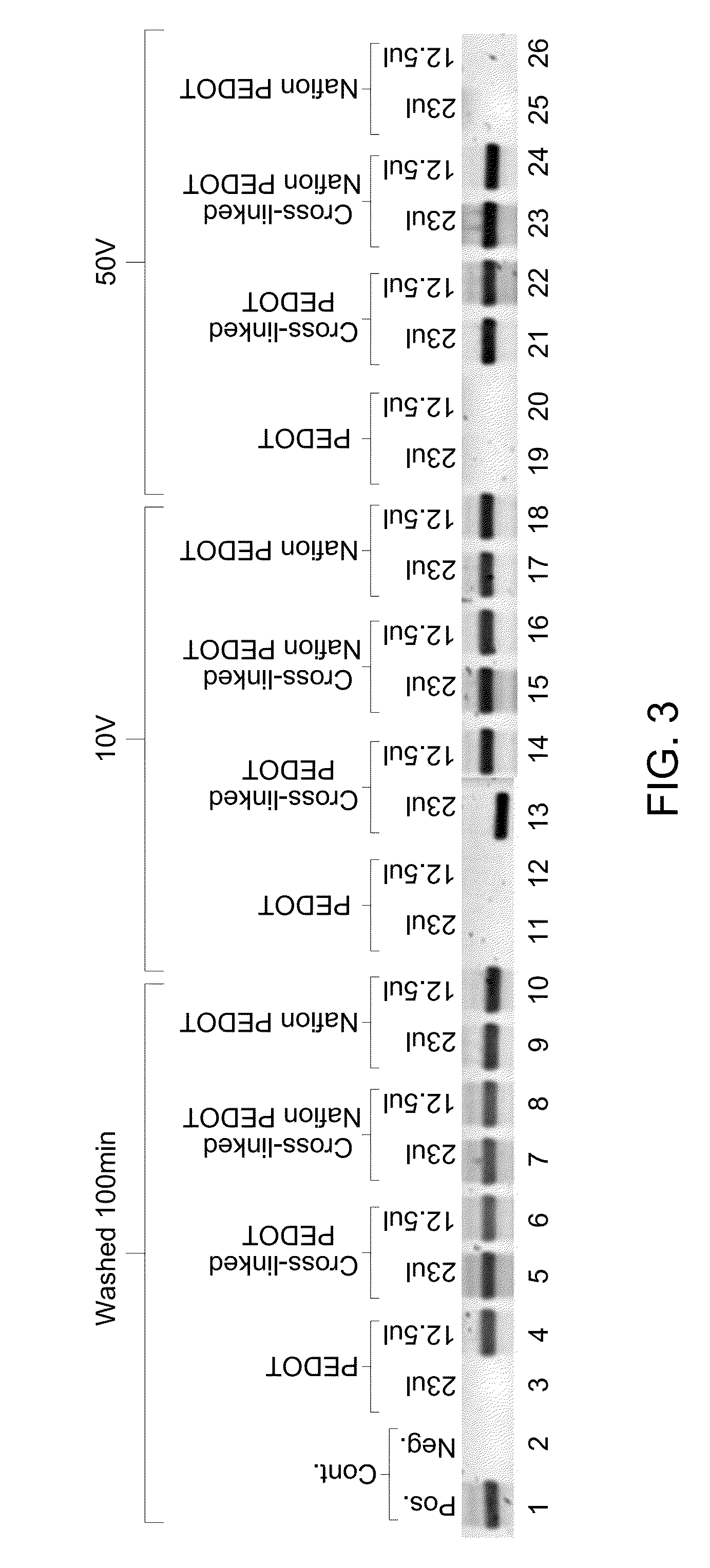Devices and systems for elution of biomolecules
a biomolecule and device technology, applied in refrigeration machines, electrodialysis, refrigeration components, etc., can solve the problems of inability to prevent, nucleic acid effect of redox polymer electrodes has not been reported, and the utility of these small devices is eroded
- Summary
- Abstract
- Description
- Claims
- Application Information
AI Technical Summary
Benefits of technology
Problems solved by technology
Method used
Image
Examples
example 1
Inhibition of Bioassays Using Conductive Monomeric or Polymeric Electrode Materials
[0078]Materials: The substrates including 31-ETF cellulose (GE-Whatman, UK), FTA™ card (from GE Healthcare) were used for sample loading followed by electroelution. Illustra PuRe Taq Ready-to-Go™ PCR beads (from GE Healthcare) were used for DNA amplification using PCR.
[0079]The use of standard conductive electrode materials, such as conductive monomers or polymers for electroelution of the biomolecules may have effect on downstream biological applications. The effect of standard conductive monomers or polymers including PSS monomers, PSS polymers and Pedot: PSS polymers on amplification of nucleic acids by polymerase chain reaction (PCR) was determined, data is presented in Table 1.
[0080]The conductive polymer electrode materials were added to the PCR mixtures, which were run in an ABI 7500 PCR machine using SYBR© Green reagents and standard curve quantification. The electrode base materials including...
example 2
Cross-Linking and Coating of Electrodes Reduce Bioassay-Inhibition
[0082]DNA was eluted from a biological sample using the device (FIG. 1). The eluted DNA was collected and exposed to an electric field, followed by testing for bioassay-inhibition. The PCR amplification reaction was effected with the eluted DNA using the device comprising different forms of Pedot:PSS electrodes. In the first set, the device contained Pedot: PSS electrodes without any cross-linking or coating, in the second set, the device contained Pedot: PSS electrodes modified with ionic-cross linking, in the third set, the device contained Pedot:PSS electrodes with ionic cross-linking and coated with Nafion® (PLBC02510), and in the fourth set, the device contained Pedot: PSS electrodes coated with Nafion®. In each of the cases, the DNA was eluted using different voltages.
[0083]The eluted DNA was washed without applying any voltage such as 0 V for 100 mins, and in other cases the eluted DNA was exposed to 10 V and 5...
example 3
Use of Conductive Redox Polymer Electrodes: Recovery of Non-Damaged DNA
[0089]One μg of human genomic DNA in solution was placed in a disposable cuvette and exposed to electric field for 1 minute at low (25 volts) or high (210 volts) voltages in presence of different types of electrodes, Platinum, Pedot, cross-linked Pedot, Nafion® coated Pedot or cross-linked and Nafion® coated Pedot. DNA was quantified using fluorometric DNA intercalating dye assay. To determine oxidative damage of DNA in contact with the electrode materials DNA samples were treated with DNA repair enzymes 8-oxoguanine DNA Glycosylase and Endonuclease IV. DNA samples were further loaded on to a 1% Agarose gel for visualization. In FIG. 4, the results are illustrated, wherein the samples which were not treated with Endo IV are indicated by (−) and those were treated with Endo IV are indicated by (+). The Endo IV treatment is also referred to herein as a “nicking assay” or “DNA damage assay”. The assay is based on id...
PUM
| Property | Measurement | Unit |
|---|---|---|
| electric field strength | aaaaa | aaaaa |
| voltage | aaaaa | aaaaa |
| applied voltage | aaaaa | aaaaa |
Abstract
Description
Claims
Application Information
 Login to View More
Login to View More - R&D
- Intellectual Property
- Life Sciences
- Materials
- Tech Scout
- Unparalleled Data Quality
- Higher Quality Content
- 60% Fewer Hallucinations
Browse by: Latest US Patents, China's latest patents, Technical Efficacy Thesaurus, Application Domain, Technology Topic, Popular Technical Reports.
© 2025 PatSnap. All rights reserved.Legal|Privacy policy|Modern Slavery Act Transparency Statement|Sitemap|About US| Contact US: help@patsnap.com



